1. What is South Asia?
- Books Name
- Education Vision Political Science Book
- Publication
- PathSet Publications
- Course
- CBSE Class 12
- Subject
- Political Science
What is South Asia?
- South Asia includes:
- Bangladesh
- Bhutan
- India
- Pakistan
- Maldives
- Nepal
- Sri Lanka
- There is linguistic, social and cultural distinctiveness among the countries.
- The boundaries of countries are not clear.
- Afghanistan and Myanmar are often included discussion of the region as a whole.
- China is an important player but not included in this region.
- Political System in South Asia
- Sri Lanka and India have democratic system and have remained democratic since independence, despite of many conflict and various problems faced.
- Pakistan and Bangladesh have both experienced civilian and military rulers.
- Pakistan: it began democratic rule in post-Cold War period, under Bhutto and Nawaz Sharif. It suffered a military coup in 1999 and thereafter run by and civilian government again since 2008
- Bangladesh remained democratic in the post-Cold War period and thereafter followed it.
- Nepal was a constitutional monarchy, but after 2008 monarchy was abolished and Nepal became a democratic republic.
- Bhutan became constitutional monarchy in 2008, under the leadership of the king it has now emerged as a multiparty democracy.
- Maldives, was Sultanate till 1968 later transformed into republic with a presidential form of government.
- In June 2005, Maldives voted for multi-party system.
- The Maldivian Democratic Party dominates the political affairs.
- After 2005, democracy purely established and opposition party also emerged. The MDP won the 2018 elections.
- All the countries wanted to be in democracy and believed in global expansion of democracy.
- All the people view the idea of democracy positively and support institution of representative democracy.
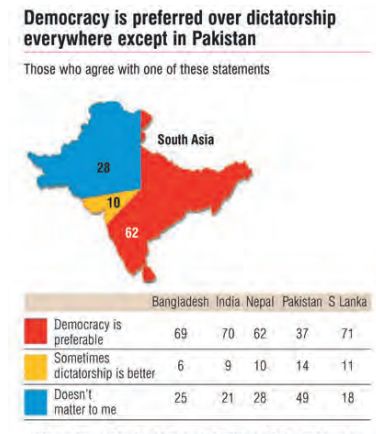
2. The Military and Democracy in Pakistan
- Books Name
- Education Vision Political Science Book
- Publication
- PathSet Publications
- Course
- CBSE Class 12
- Subject
- Political Science
The Military and Democracy in Pakistan
- Sequence of Rule:
- General Ayub Khan
- General Yahya Khan
- Elected Government of Zulfikar Ali Bhutto (1971-77)
- General Zia-ul-Haq
- Benazir Bhutto
- Nawaz Sharif
- General Musharraf
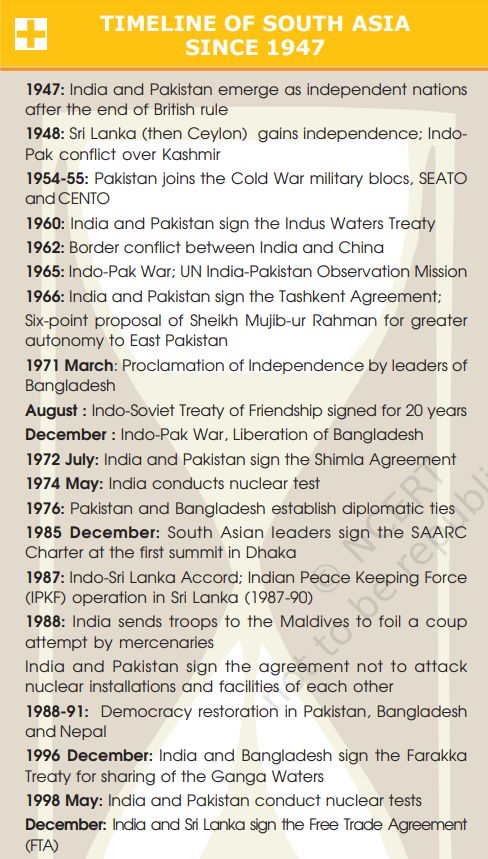
- After first constitution was formed general Ayub Khan, got himself elected.
- Dissatisfaction with his rule, there was military took over by General Yahya Khan.
- During Yahya’s rule Pakistan faced Bangladesh crisis, and after a war with India in 1971, East Pakistan broke away and emerged as an independent country called Bangladesh.
- After this, elected government of Zulfikar Ali Bhutto was in power in Pakistan from 1971 to 1977.
- Bhutto government was removed by General Zia-ul-Haq in 1977.
- In 1982, there was pro-democracy movement by people and again an elected government took over in 1988 under leadership of Benazir Bhutto.
- Benazir Bhutto was daughter of Zulfikar Ali Bhutto.
- After she became the P.M. in 1988 political system prevailed in Pakistan just like Indian democracy.
- There were two parties in total namely the Pakistan People’s Party and the Muslim League.
- Benazir Bhutto was of Pak istan People’s Party.
- The democracy lasted till 1999. And General Pervez Musharraf removed the current P.M. Nawaz Sharif.
- In 2001, General Musharraf got himself elected as President.
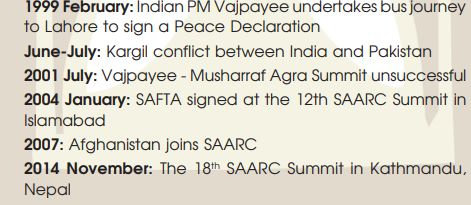
- It continued to be ruled by army, yet rulers have held elections to give their rule a democratic image.
- Since 2008, democratically elected rulers have been ruling Pakistan.
- Factors responsible for failure of stable democracy building in Pakistan:
- Social dominance of the military, clergy, and landowning aristocracy.
- Conflicts with India made pro-military groups more powerful.
- Some think that Pakistan’s security would be harmed by selfish-minded people/parties so therefore army’s stay in power is justified.
- The lack of genuine international support for democratic rule, has further encouraged the military dominance in Pakistan.
- The United Stated and other Western countries have encouraged military rule for their own reasons.
- Other countries also feared from the threat of ‘global Islamic terrorism’ and the apprehension that Pakistan’s nuclear arsenal might fall into the hands of terrorist groups.
- The military regime in Pakistan has been seen as the protector of the Western interests in West Asia and South Asia.
- Pakistan population has a pro-democracy sentiment and there is free press and a strong human rights movement.
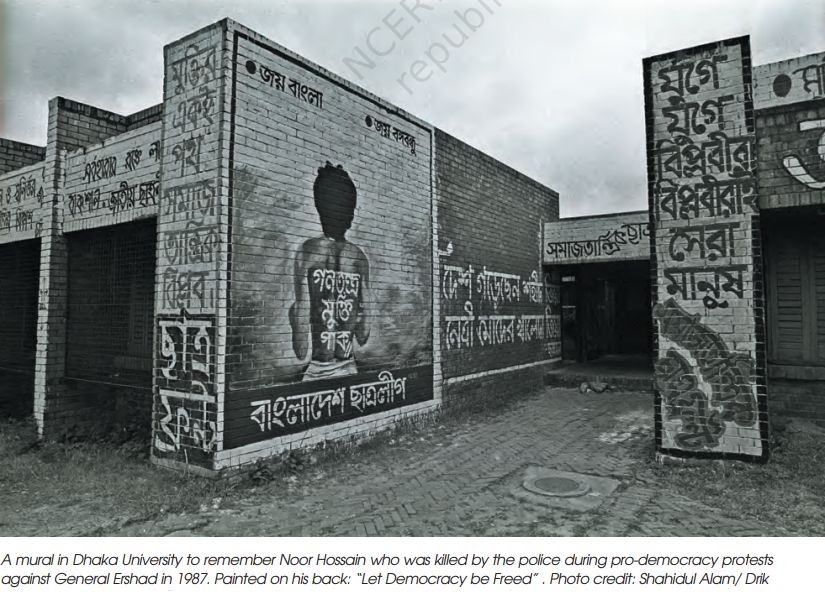
3. Democracy in Bangladesh
- Books Name
- Education Vision Political Science Book
- Publication
- PathSet Publications
- Course
- CBSE Class 12
- Subject
- Political Science
DEMOCRACY IN BANGLADESH
- Bangladesh was a part of Pakistan from 1947 to 1971.
- It consisted partitioned areas of Bengal and Assam from British India.
- The people here resented over the domination of wester Pakistan and the imposition of the Urdu language.
- After the partition people started protesting against the unfair treatment towards Bengali culture and language.
- They demanded fair representation in administration and a fair share in political power.
- Sheikh Mujib-ur Rahman led the popular struggle again the West Pakistani domination, he demanded autonomy for eastern regions. He demanded complete autonomy for eastern regions.
- In 1970, elections were held in Pakistan. The Awami League led by Sheikh Mujib won all seats in East Pakistan and secured a majority in constituent assembly.
- But the West Pakistan leadership refused to convene the assembly.
- Sheikh Mujib was arrested.
- Yahaya Khan, the Pakistani army tried to supress Bengali mass movement of people.
- Thousands were killed and there was wide scale migration to India.
- Government of India supported East Pakistan and helped them financially and militarily.
- Which led to war between India and Pakistan in December 1971, Pakistan army surrendered and the formation of Bangladesh as an independent country was successful.
- Bangladesh after independence from West Pakistan:
- Bangladesh drafted its constitution in declaring its faith in secularism, democracy and socialism.
- In 1975, Sheikh Mujib got the constitution amended to shift from the parliamentary to presidential form of government.
- He abolished all the parties except its own the Awami League. He was assassinated in a military uprising in August 1975.
- The new military ruler, Ziaur Rahman, formed his own Bangladesh National Party and won the elections in 1979.
- He was assassinated which was then followed by another military takeover by Lt Gen H.M.Ershad.
- The people of Bangladesh rose in favour for democracy, and the students were in forefront and Ershad allowed political activity on a limited scale.
- Ershad was later elected as president for 5 years, followed by mass public protests he had to step down in 1990.
Elections were held in 1991, and thereafter democracy based on multi-party system has been working in Bangladesh.
4. Nepal : Monarchy & Democracy
- Books Name
- Education Vision Political Science Book
- Publication
- PathSet Publications
- Course
- CBSE Class 12
- Subject
- Political Science
MONARCHY AND DEMOCRACY IN NEPAL
- Nepal was a Hindu Kingdom in the past and then a constitutional monarchy for many years.
- People always wanted democracy, but the King with the help of the army always restricted the expansion of democracy in Nepal and retained full control over government.
- There were pro-democracy movements and king accepted the demand for new democratic constitution in 1990.
- Democratic government had a troubled career, in nineties Maoists spread their influence, they believed in armed insurrection against the monarch and the ruling elite.
- This led to a triangular conflict among the monarchist forces, the democrats and the Maoists.
- In 2002, the king dismissed the government.
- In 2006, there was massive pro-democracy protests, they first victory was when the king was forced to restore the House of Representatives which was dissolved in April 2002.
- The non- violent movement was led by the Seven Party Alliance (SPA), the Maoists and social activists.
- Nepal transition to democracy is ongoing:
- Its constituent assembly is still drafting its constitution.
- Some think nominal monarchy is important to retain its link with past
- Maoist wanted the constitution to include the radical programmes of social and economic restructuring
- The Maoists and some other political parties were suspicious of the Indian government and its role in the future of Nepal.
- Nepal became democratic republic in 2008.
- In 2015 it adopted a new constitution.
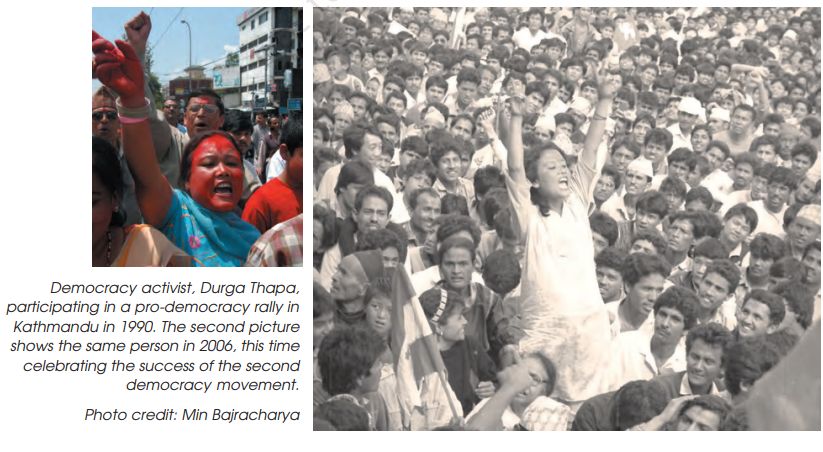
ETHNIC CONFLICT AND DEMOCRACY IN SRI LANKA
- Sri Lanka got independence in 1948.
- Sri Lanka was earlier known as Ceylon.
- After India’s independence many Tamils migrated from India to Sri Lanka and settled there, migration continued even after independence.
- Sinhala’s nationalists did not want Tamils from India to come to Sri Lanka as they believed Sri Lanka belonged to Sinhala people only, it led to militant Tamil nationalism.
- From 1983, the militant organization, the Liberation Tigers of Tamil Eelam (LTTE) has been fighting with the army of Sri Lanka and demanding “Tamil Eelam” i.e., separate country for Tamils of Sri Lanka.
- The LTTE controlled the northeasters parts of Sri Lanka.
- The Government of India has negotiating with Sri Lankan government on Tamil question, in 1987 the Indian government got involved with in Sri Lankan Tamil question.
- And signed an accord with Sri Lanka and sent troops to stabilise relations between Sri Lankan government and the Tamils.
- And Indian Army got into fight with LTTE and this was seen as India interfering in internal affairs of Sri Lanka.
- And in 1989, the Indian Peace Keeping Force (IPKF) pulled out without attaining its objectives.
- The Sri Lankan crisis continued to be violent, Norway and Iceland tried to bring the warring groups to negotiations.
- The conflict came to an end, as LTTE was vanquished in 2009.
- Sri Lanka was one of the first developing countries to successfully control the rate of growth population, also first to liberalise the economy and it had highest per capita GDP for many years.
- Despite of internal conflicts it has maintained a democratic political system.
5. India-Pakistan Conflicts
- Books Name
- Education Vision Political Science Book
- Publication
- PathSet Publications
- Course
- CBSE Class 12
- Subject
- Political Science
INDIA-PAKISTAN CONFLICTS
- Fate of Kashmir
- War of 1947-49 and 1965 failed to settle the conflict over the fate of Kashmir.
- War of 1947-48 resulted in division of province occupied by Kashmir and the Indian province of Jammu and Kashmir by the Line of Control.
- War of 1971 was won by India but the Kashmir issue was still not settled.
- War of 1947-49 and 1965 failed to settle the conflict over the fate of Kashmir.
- Strategic Issues
- Control over Siachen glacier
- Acquisition of arms
- India tested its 1st weapon nuclear explosion in Pokaran.
- Pakistan in return conducted its nuclear tests in Chagai Hills.
- Both have built a military relationship where possibility of a direct and full-scale war has declined.
- Suspicious Government
- Both the country’s government doubt on each other.
- Terrorist Activity
- Indian Government blames Pakistan for helping Kashmir militants to carry out terrorist strikes against India.
- Indian Government also believes that Pakistan had aided the pro-Khalistani militants with ammunitions during the period of 1985-1995.
- Pakistan’s spy agency Inter Services Intelligence (ISI), has also been accused for being involved in anti-India campaigns in northeast part of India.
- In return Pakistan blames Indian Government to promote trouble in the provinces of Sindh and Baluchistan.
- River Water Disputes
- Till 1960, there was argument regarding the use of the rivers of the Indus basin.
- In 1960, Indus Water Treaty was signed between the two countries with the help of World Bank.
- But despite of the treaty signed both the countries are not in demarcation line in Sir Creek in the Rann of Kutch.
- India and Pakistan are holding negotiations on all the issues.
6. India and Its other Neighbours
- Books Name
- Education Vision Political Science Book
- Publication
- PathSet Publications
- Course
- CBSE Class 12
- Subject
- Political Science
INDIA AND ITS OTHER NEIGHBOURS
- Bangladesh:
- 1st conflict – sharing of river water of Brahmaputra and Ganga river waters.
- Indian government does not like
- Denial off Bangladesh on illegal immigration of people to India.
- Its support for anti-Indian Islamic fundamentalist groups.
- Bangladesh’s refusal to allow Indian troops to move through its territory.
- Bangladesh’s decision not let India/Myanmar to export natural gas through its territories.
- Bangladesh government feels that
- Indian government behaves like a regional bully over sharing river
- Indian government’s encouragement of rebellion in Chittagong Hill tracts.
- Indian government is trying to extract its natural gas and being unfair in trade.
- Economic relations of both the countries have improved considerably.
- Bangladesh is part of India’s Look East policy.
- Both the countries have regularly cooperated on disaster management and environmental issues.
- In 2015, they have also exchanged certain enclaves
- Nepal
- Both the countries have a special relation.
- A treaty between two countries allows the citizens of both the countries to travel and work in the other country without visas and passports.
- Conflicts:
- India does not like the warm relationship between Nepal and China.
- India also does not like Nepal government’s no action against anti-Indian elements.
- Indian security agencies see the Maoist movement in Nepal as a security threat.
- Nepal citizens/government feel that Indian government interferes in Nepal’s internal affairs, has its design on its river-waters.
- Nepal government also feels Indian government stops Nepal from getting easier access to the sea through Indian territories.
- Despite all the differences, trade, natural resources etc. hold the two countries together.
- Sri Lanka
- The difficulties in the relationship between both the governments of both the countries are over ethnic conflicts.
- Indian leaders cannot remain neutral when Tamils in the Sri Lanka are unhappy and are being killed.
- After military intervention in 1987, the Indian government stick to the policy of disengagement vis- à-vis Sri Lanka’s internal troubles.
- India has signed a free trade agreement.
- India’s help in post-tsunami reconstruction in Sri Lanka has also brought the two countries closer.
- Bhutan
- Both have a special relationship.
- The efforts by Bhutanese monarch to throw out the militants and guerrillas from their country has been helpful to India.
- India is also involved in big hydroelectric projects in Bhutan and remains Himalayan kingdom’s biggest source of development aid.
- Maldives
- They have a good and warm relations.
- In November 1988, Maldives requested India to help stop invasion by Tamil mercenaries and it reacted quickly to its request and helped.
- India has also contributed toward the island’s economic development, fisheries etc.
- Majorly conflicts of India and other countries is because of the geography of the region, as India is situated centrally and is therefore the only country that borders others.
Peace and Cooperation
- SAARC (South Asian Association for Regional Cooperation), it is initiative by the South Asian states to cooperate through multilateral means
- SAARC begun in 1985.
- SAARC member signed the South Asian Free Trade (SAFTA), it promised the formation of a free trade zone for the whole of South Asia.
- SAFTA was signed in 2004 and came into effect on 1 January 2006.
- Objectives SAFTA:
- Establishing free trade regime in South Asia
- Lowering trade tariffs.
- India believes that there are economic benefits of for all from SAFTA.
- Some in India also think that as India already has bilateral agreements with Bhutan, Nepal and Sri Lanka so it is not worth the trouble.
- Cooperation of India-Pakistan:
- Friendly atmosphere
- Confidence building measures have been taken by both countries.
- Both countries attend summits, UN meeting to better understand each other’s problem and find solution accordingly.
- Bus routes (2005) has started between India and Pakistan.
- Visa’s are also given easily.
- China and the United States are key players of South Asian politics.
- Sino-Indian relations has improved in last 10 years, but China’s partnership with Pakistan is a major irritant.
- Demands of development has brought China and United States together and economic ties have multiplied rapidly since 1991.
- The US is also a moderator in India-Pakistan relations.
SAARC
- South Asian Association for Regional Cooperation, it was established with the signing of SAARC charter in Dhaka in 1985.
- Founding member of SAARC:
- Bangladesh
- Bhutan
- India
- Maldives
- Nepal
- Pakistan
- Sri Lanka
- Afghanistan joined SAARC in 2007
- Its permanent headquarter is in Kathmandu, Nepal.
- Objectives of SAARC:
- To promote the welfare of the people of South Asia and to improve their quality of life.
- To accelerate economic growth, social progress and cultural development in the region and to provide all individuals opportunity to live in dignity and to realise their full potential.
- To promote and strengthen collective self-reliance among the countries of South Asia.
- To contribute to mutual trust, understanding and appreciation of one another problems
- To promote active collaboration and mutual assistance in the economic, social, cultural, technical and scientific fields.

 PathSet Publications
PathSet Publications
